Compare
Free shipping
Best price guarantee
Special pricing
Financing with Resolve
Easy returns

Over the last few decades, pickup trucks and SUVs have dominated the automotive market. They’re a popular choice for all kinds of reasons; they’re comfortable, practical, and durable, and they give you the option of being able to haul furniture or a load of mulch or sheets of drywall from the home improvement store or what-have-you, without breaking a sweat.
Many of those trucks are, of course, equipped with four-wheel-drive. If you take your truck around anywhere other than strictly on the pavement all the time, you’re going to need durability and dependable grip for rough terrain and tricky conditions, the kind of performance where most all-season light truck tires are going to fall short of being able to get the job done for you. For that kind of driving, you need all-terrain tires…but all-terrain tires aren’t the only option on the market.
We’re going to discuss all-terrain tires, mud-terrain tires, and rugged-terrain tires (AT, MT, and RT) and lay out some of the key differences between them in construction, design, and performance targets, complete with their pros and cons. We will also discuss what would make each kind of tire a great choice (or maybe not-so-great) for your vehicle, driving style, and needs.
What are All-terrain tires
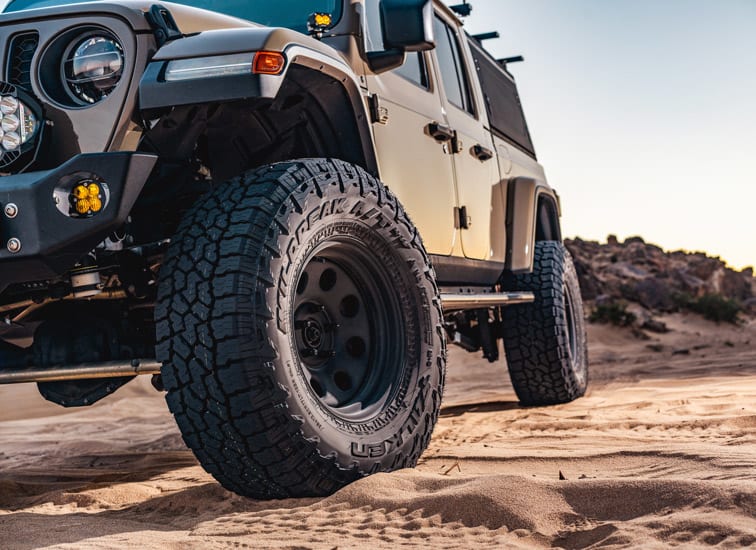
All-terrain tires have come a long way in recent decades. For many years, the stereotype was that AT tires were rugged and durable and delivered excellent performance in loose dirt, mud, snow, sand, and difficult, challenging terrain but were also sluggish, noisy, and rough on the pavement. That’s all changed over the years, though – today’s AT tires are designed for the best of both worlds, with that same dependable traction and durability for off-road along with civilized road manners, good stability, low noise, a refined ride, and easy handling on the pavement.
Every generation of pickup trucks and SUVs is a little more sophisticated than the generation before, and AT tires have had to evolve along with them. Today’s AT tires are designed around the power, torque, weight, suspension, load capacity, and overall driving dynamics of modern trucks and SUVs. That means they’re built with a durable, long-wearing, damage-resistant tread formulation that stands up to cuts and punctures, reinforced internal construction for extra load capacity, and an aggressive tread pattern that features a wide void ratio (rubber vs groove, sometimes called “land/sea ratio”) that allows it to easily self-clean and shed mud and debris so there’s always a clear section of the tire to dig in as the wheel turns. AT tire tread designs will also usually include deep initial tread depth for traction and long wear and often tread lugs at the shoulder that wrap around onto the tire’s sidewall for enhanced lateral traction (which comes in handy for cornering and clawing out of ruts). The best all-terrain tires also have the 3 Peak Mountain Snowflake certification for severe winter service, a rating that doesn’t come easily as the tire industry sets the bar pretty high for 3PMSF.
As rugged and capable as AT tires are for off-road conditions, the best AT tires are also designed for a great balance of on-pavement performance and off-road grip. That means a tread pitch that’s randomized and computer-tuned to keep road noise to a minimum by canceling certain frequencies and overtones and a casing that helps cushion the ride from vibrations and roughness and isolate passengers from bumps and irregularities. They’re also designed for steering response and cornering that are predictable and accurate, if maybe not as nimble as what you’d expect from a performance tire, and road manners that are stable and secure on the highway. Most AT tires also include a generous manufacturer’s tread life warranty, making them a great value and performer with little compromise between pavement and off-road performance.
What are Rugged terrain tires
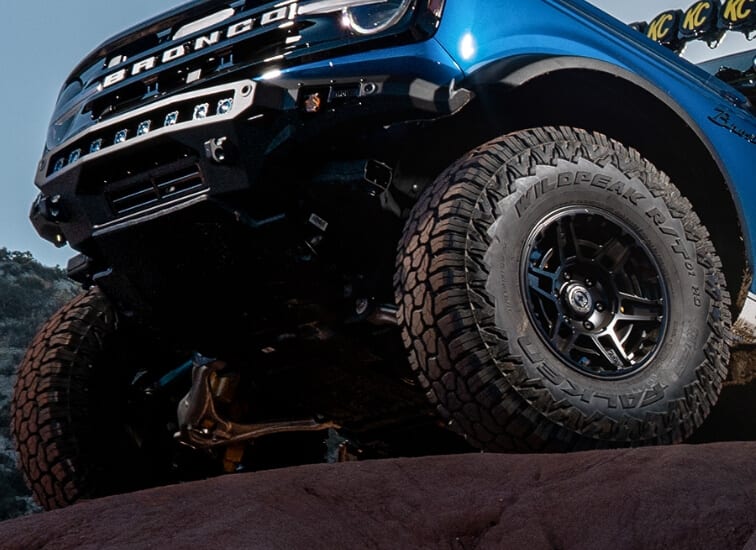
Rugged-terrain tires are a fairly new category in the tire industry. Mud-terrain tires (which we’ll get into more in a minute) are designed for the extremes of off-roading, in the deepest, stickiest mud, and aired-down performance over steep grades, rocks, and obstacles. RT tires are designed to more or less split the difference between AT and MT tires in design and performance.
Also sometimes known as hybrid-terrain tires (not surprisingly), RT tires take all the design elements and performance targets of AT tires and up the game. They include damage-resistant tread compounds, reinforced internal construction (often with 2- or 3-ply sidewall), and large tread blocks with wide void ratios for good mud and debris evacuation. RT tires also typically feature a dense sipe network, multiplying the tread’s surface area and traction with hundreds of hair-thin grooves that allow it to dig in and chew through snow, slush, and mud. Many RT tires are designed with winter traction as a priority and have the 3 Peak Mountain Snowflake rating.
Compared to MT tires, RT tires are similar to that design, with much the same construction, rubber compounds, tough multi-ply sidewalls, and aggressive tread patterns. They’re not, however, as tough or extreme-traction-oriented as MT tires. RT tires are usually lighter (usually) for lower rolling resistance and improved fuel economy and are designed more for composed and civilized behavior on the road than MT tires. And like AT tires, most RT tires come from the factory with a generous limited manufacturer’s tread life warranty.
What are Mud terrain tires
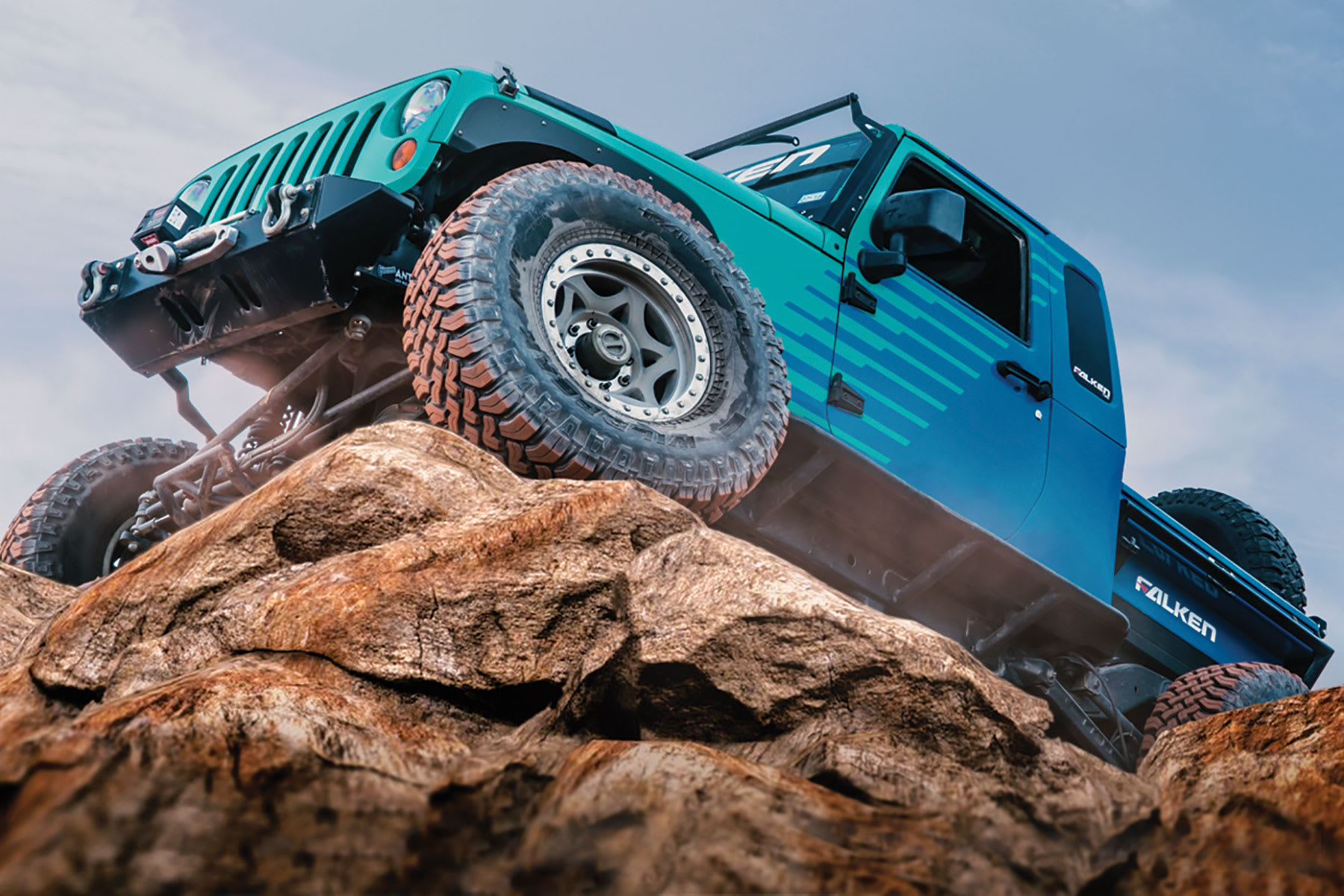
Now we come to mud-terrain tires. MT tires are just like the name suggests: they’re designed for the nastiest, stickiest, soupiest kind of mud and are better in those conditions than on pavement. They tend to be taller and bigger for trucks with extra ground clearance and lift kits, as well as deep and aggressive tread blocks and grooves. They also tend to be heavier, affecting braking distances, handling, and fuel economy; heavier tires and wheels are considered “unsprung weight”, and it takes more effort from the truck’s braking system to slow down their momentum. That extra weight also makes it difficult for tire shops to balance MT tires properly in many cases.
All those sound like negatives, but where MT tires excel is in their element…mud. They can plow through conditions where AT tires would be likely to get bogged down and lose traction, conditions that can also include deep snow and sand. For serious off-roaders, MT tires can be used “aired-down” at an inflation pressure of 10 psi, easily conforming around boulders, tree stumps, logs, and other obstacles for rock crawling over steep terrain and demanding conditions. They’re also designed with extra-tough tread compounds and internal design details, including reinforced sidewalls and high-tensile steel belt packages, for the tenacious durability you need in such situations.
All-terrain vs. Rugged terrain vs. Mud terrain tires on-road
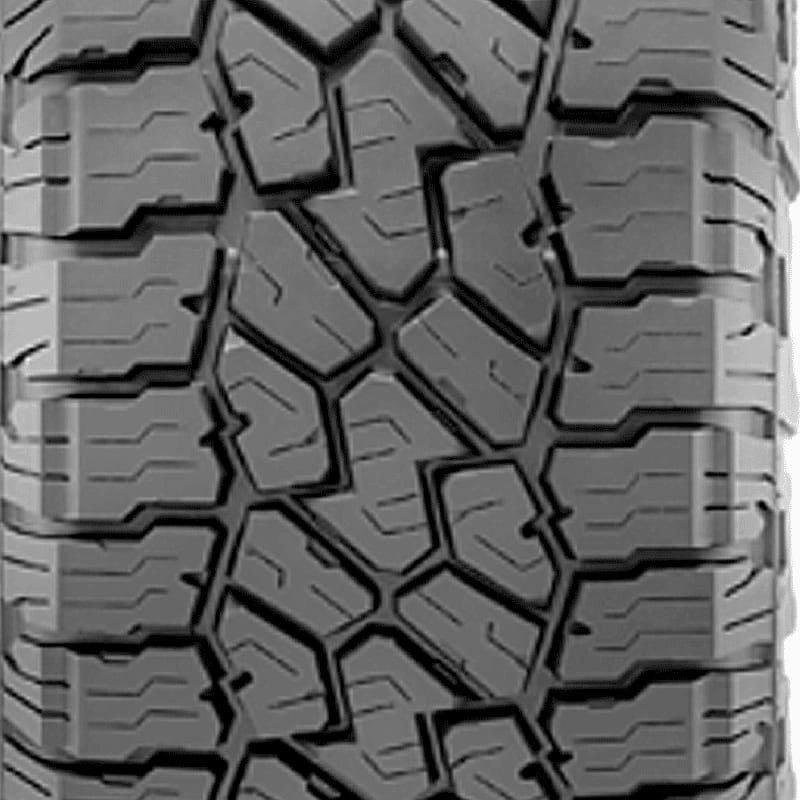
So, how do AT, RT, and MT tires perform on the highway? As mentioned above, the best AT tires are composed, civilized, and predictable on the highway. That means ride quality that’s refined and comfortable, straight-line stability that’s solid at highway speed, low noise levels, and predictable and accurate handling. The best AT tires are more like what you’d expect from an all-season or Grand Touring tire regarding a civilized demeanor on the pavement. RT tires are designed around the same performance goals for street use, although they might come with a little extra noise on some pavement surfaces.
MT tires, on the other hand, are really at their best in mud and rough off-road terrain. It’s what they’re designed for, and they tend to be noisy and rough on the pavement. That’s not across the board, as many newer MT tire designs are tuned for lower noise and better ride quality. Still, MT tires' tread designs and extra rigid construction mean they can have a choppy ride and many tire drones at highway speed. They also tend to be slightly more squirrely and less stable at higher speeds, with more cumbersome handling and a slower steering response. They can sometimes lose their composure more easily over irregular pavement surfaces like washboard roads or rough railroad crossings.
All-terrain vs. Rugged terrain vs. Mud terrain tires off-road
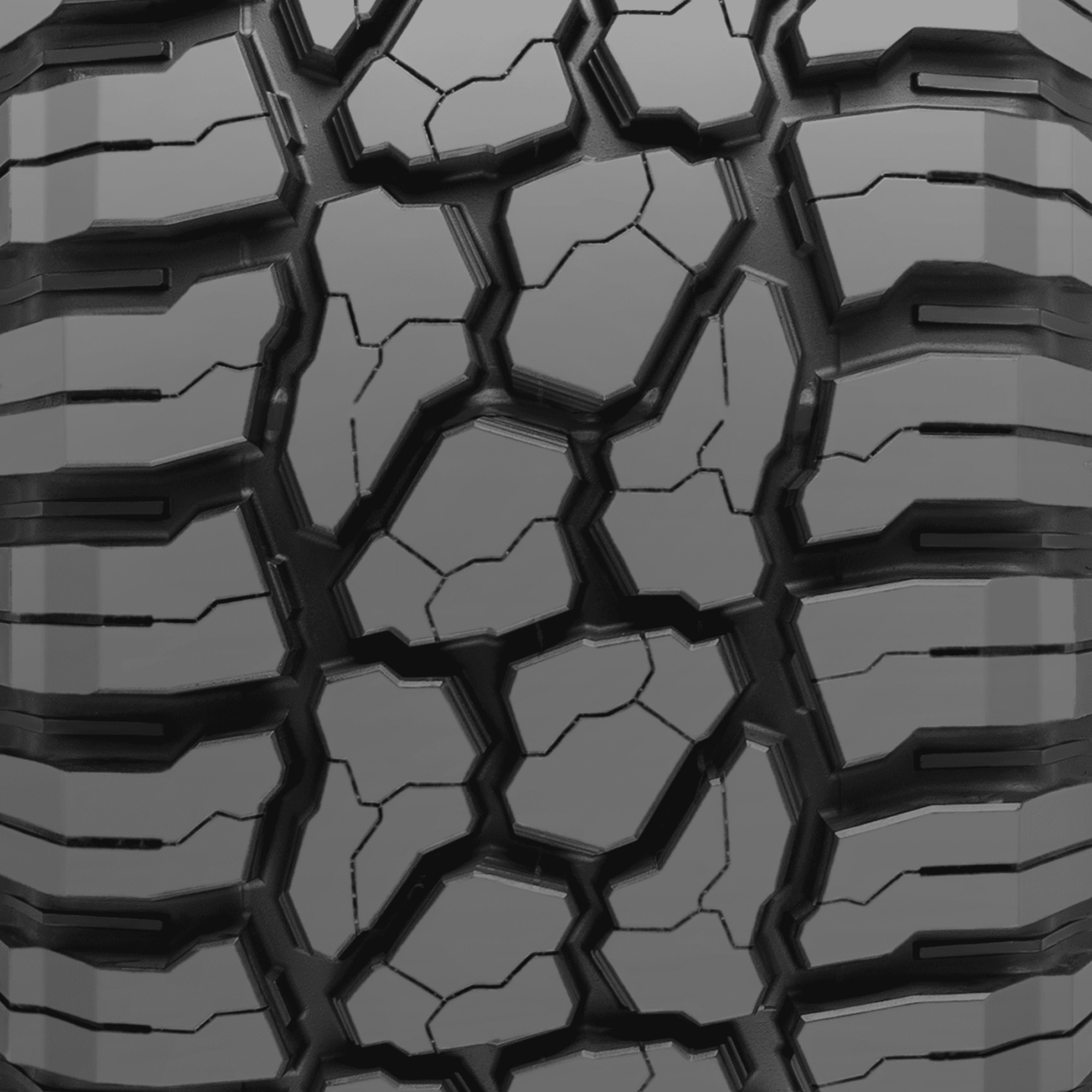
Off-road performance and mud-terrain tires are at the top of the heap. As mentioned above, MT tires can get through thick, sticky mud, deep sand, steep boulders, snowbanks, and other conditions where many other tires are just likely to leave you stranded and needing a winch. Thanks to their durable construction, specialized tread blocks, and extra-grippy, extra-tough tread formulations.
Rugged-terrain tires come in second, with enhanced traction in snow and improved performance in deeper mud or sand. As we mentioned, the RT tire is designed to compromise AT and MT performance, with enhanced traction for situations where AT tires might not quite get done, and often with a 3PMSF certification for snow and slush. Some MT tires (and some AT tires, for that matter) are pre-drilled with a series of holes in the tread that make it easy for a tire shop to install metal or plastic studs for extreme winter weather and icy conditions (always remember to check state laws for the legality of studded tires where you live, and any calendar restrictions on their use).
All-terrain tires are great for most off-road situations like hardpack dirt, loose dirt, mud, sand, gravel, or a few inches of snow. The truth is, most drivers of 4WD-equipped light trucks aren’t going to subject their vehicles to much worse off-road conditions than that, anyway. They’re also designed to be durable enough to stand up to rough treatment and easily handle heavier loads in the truck bed or pulling a trailer. If you don’t plan on rock crawling, mud-bogging, or putting your truck through off-road rallies and competitions, all-terrain tires will certainly be more than capable.
All-terrain vs. Rugged terrain vs. Mud terrain tires fuel efficiency
Think about what riding a bicycle with wide, fat, knobby tires is like versus riding a bike with skinnier street tires. The fat tires take a lot more effort to get the bicycle going and to keep it headed down the street, and that’s kind of what mud-terrain tires are like. Rolling resistance refers to the friction a tire generates and how much energy the vehicle’s drivetrain takes to get rolling and keep heading down the road. MT tires have a fatter footprint and heavyweight construction that cuts into that efficiency. Long story short, MT tires tend to be a drag on fuel efficiency and hydrocarbon emissions.
Newer, more advanced designs of AT tires focus on lower rolling resistance and lower weight, with alterations to the tire’s tread formulation, tread pattern, and internal construction making that possible. Many variables go into lower rolling resistance, including even the aerodynamics of the tire’s shape and its sidewall design, and many RT tires adopt some of those same technologies and design principles from their AT tire brethren. If fuel efficiency and rolling resistance are among your priorities, you can find AT and RT tires designed with that in mind.
All-terrain vs. Rugged terrain vs. Mud terrain tires tread life
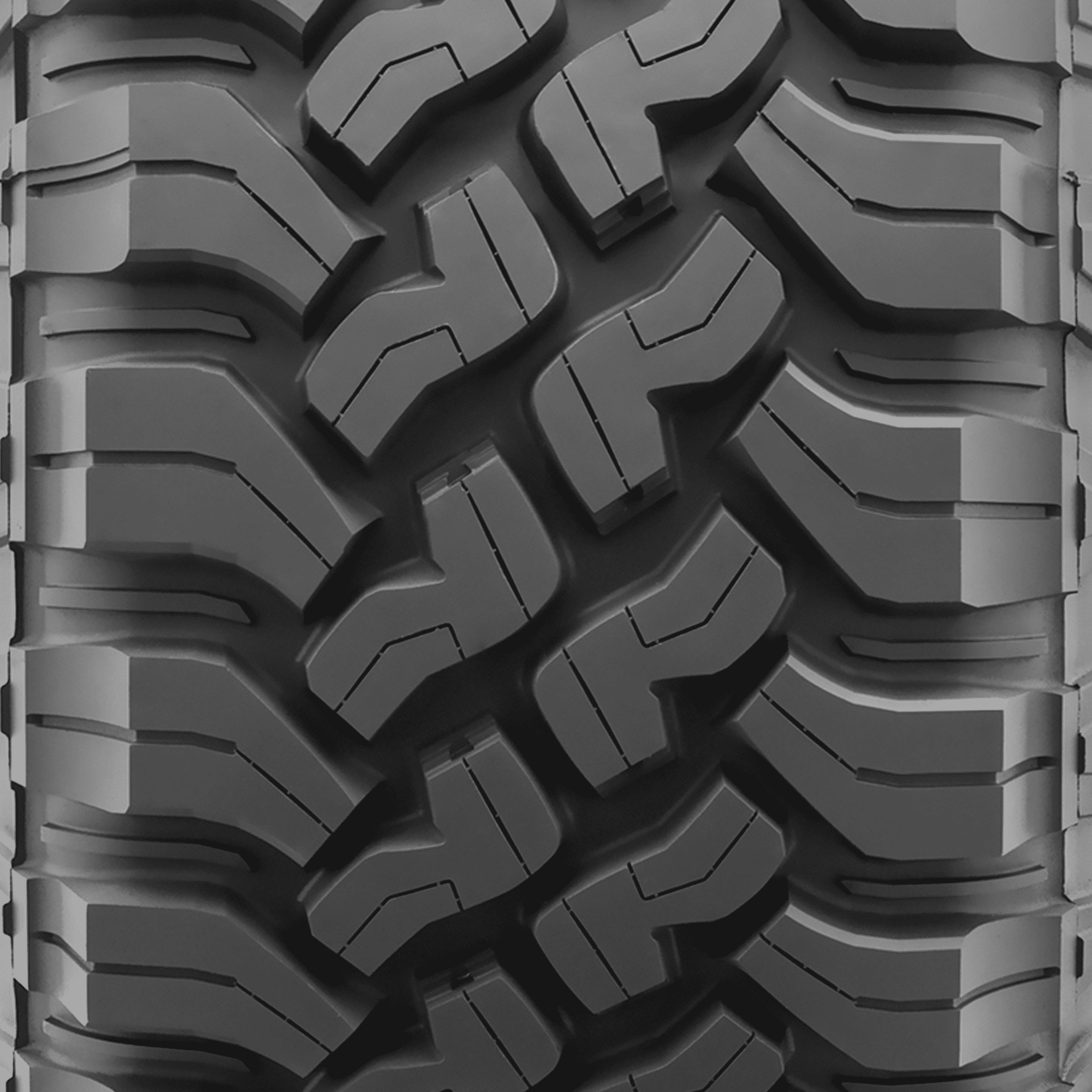
Regarding tread life and longevity, let’s talk about mud-terrain tires first. MT tires are designed for durability and traction in off-road conditions, but ironically, being driven on pavement can shorten their life and wear down their tread blocks prematurely. Tire manufacturers usually do not offer a limited tread life warranty with MT tires, partly because they know that drivers will put their MT tires through some pretty serious punishment. MT tires can be expected to last 20,000-30,000 miles at best, although that can be stretched out a bit with proper tire maintenance like rotations, balancing, and alignment checks.
On the other hand, all-terrain and rugged-terrain tires are designed for better pavement wear properties and usually come with a warranty for 30,000-60,000 miles or so. Tread compounds, internal construction, and tread patterns are all optimized for driving on the highway as much as for off-road use, including longevity and wear properties.
We should mention here that, of course, the longevity of any set of tires, whether they’re MT, RT, or AT designs, has a lot to do with your driving habits. Hard braking, hard acceleration and wheelspin, rough treatment, poor maintenance, and hard cornering can all shave tens of thousands of miles off the life expectancy of any set of tires, so you should be mindful of that as well if you want to get the most for your money out of your tires.
When to use each
What are your needs for a set of tires, and what are your driving habits like? If you’ve got a big pickup with a lift kit and extra ride height, you probably want to be able to get down and dirty in the biggest, nastiest mud or rock-crawling over steep boulders and obstacles. If that sounds like you, mud-terrain tires are probably your best bet for their durability and purpose-built traction. Be mindful of the tradeoffs of using MT tires on the street, and you should be fine.
Do you live in an area where hard winter weather means snow that lingers on the streets for days, along with maybe ice, frozen slush, and snowdrifts? It’d probably be best to look around for a set of Three Peak Mountain Snowflake-rated rugged-terrain tires. Even without the 3PMSF certification, RT tires generally deliver superior performance in snow and slush than many all-terrain tires can. Of course, pre-drilled RT tires are available to install studs for icy roads. The tough construction and enhanced grip of RT tires make them a good choice for commercial vehicles and work trucks that haul heavier loads, pull trailers, or run around rough job sites without risking damage.
If you live in a rural area where you have to negotiate ranch roads, logging roads, and oilfield lease roads, or if you need to return to the boonies for camping trips or fishing expeditions, all-terrain tires can be a great solution. AT tires mean you can get that kind of grip and performance over various terrains without giving up too much in the way of road manners and composed performance on streets and highways. AT and RT tires are often covered by generous limited manufacturer’s tread life warranties.
Which one should you choose?

What are your needs for a set of tires? If you’re the kind of driver who loves mud, rocks, and rough terrain, then rugged-terrain or all-terrain tires might not be for you. If that’s the case, mud-terrain tires are about the only thing that can dependably get the job done…but if you want a set of MT tires because they’re big and aggressive and look all cool and macho on your truck (while you don’t go off-road that much), you’re likely to be disappointed. Remember that MT tires have a shorter life expectancy, are noisy, and can be a little squirrely on the pavement, with a tendency to wander and sluggish, clumsy handling and steering response.
If you want an enhanced grip for rough conditions but don’t want to go as extreme as a set of MT tires, consider RT tires with reinforced construction, enhanced traction, and a more durable tread compound. They split the difference between AT and MT tires in all those respects, but without the penalty and disadvantages that can go with MT tires.
For most drivers, all-terrain tires will be the way to go. AT tires balance the driving dynamics on pavement that won’t make you crazy (predictable handling, ride comfort, low noise, good road manners) and durable, dependable grip off the road. They’re designed specifically for 4WD trucks, and the best premium AT tires are designed in conjunction with automakers to be the best fit for their trucks and the kind of performance needs they present.
Ready to find the perfect tires?
Search By